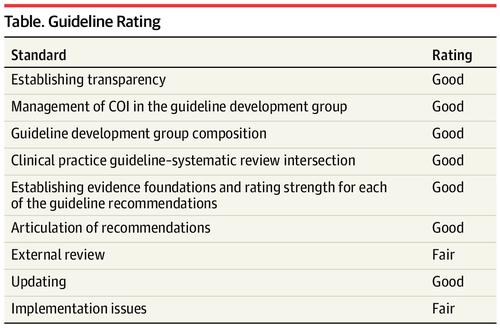JAMA ( IF 63.1 ) Pub Date : 2020-05-12 , DOI: 10.1001/jama.2020.4914 Jason T Poston 1 , Bhakti K Patel 1 , Andrew M Davis 2

|
Severe acute respiratory syndrome coronavirus 2 (SARS-CoV-2) is the cause of COVID-19, a pandemic that has affected more than 400 000 individuals and caused nearly 20 000 deaths as of late March 2020. Approximately 5% to 10% of patients require intensive care unit (ICU) admission and mechanical ventilation.1
The Surviving Sepsis Campaign (SSC) has previously published a series of guidelines for sepsis and septic shock. Based on this experience, experts were recruited to write guidelines on the management of COVID-19 in critically ill adults. These guidelines were authored by 36 experts from 12 countries (Table).2 Recommendations were developed based on limited direct evidence with COVID-19 cases and indirect evidence derived from previous pandemics such as Middle East respiratory syndrome (MERS), severe acute respiratory syndrome (SARS), and other coronavirus infections. Overall, the panel issued 54 statements: 4 best practice statements, 9 strong recommendations, and 35 weak recommendations. (No recommendations were made for the remaining 6 topics.)
The GRADE method was used, with the actionable guideline questions placed in population, intervention, comparator, outcomes (PICO) format. The first discusses PPE to protect health care workers and prevent nosocomial spread of virus. A recent clinical trial of 2862 health care personnel at 137 outpatient sites compared the use of N95 respirators vs medical masks and found no significant difference in the incidence of laboratory-confirmed influenza (8.2% vs 7.2% health care personnel seasons; difference, 1.0% [95% CI, −0.5% to 2.5%]; P = .18) (adjusted odds ratio, 1.18 [95% CI, 0.95-1.45]).3 The CDC recently discussed strategies for optimizing the supply of face masks.
中文翻译:

对COVID-19的重症成人的管理。
严重的急性呼吸综合症冠状病毒2(SARS-CoV-2)是COVID-19的病因,截至2020年3月下旬,这一大流行已影响了40万多人,并导致近20000人死亡。约有5%至10%患者需要重症监护病房(ICU)入院和机械通气。1个
幸存败血症运动(SSC)先前已经发布了一系列败血症和败血性休克指南。基于这些经验,招募了专家编写重症成人COVID-19管理指南。这些指南由来自12个国家的36位专家撰写(表)。2建议是基于有限的COVID-19病例直接证据和先前流行病(例如中东呼吸综合征(MERS),严重急性呼吸综合征(SARS)和其他冠状病毒感染)得出的间接证据制定的。总体而言,该小组发表了54项声明:4项最佳实践声明,9项强建议和35项弱建议。(未对其余6个主题提出任何建议。)
使用GRADE方法,将可行的指南问题放在人群,干预措施,比较者,结果(PICO)格式中。第一部分讨论了个人防护装备,以保护医护人员并防止病毒在医院内传播。一项最近的一项临床试验在137个门诊处对2862名医护人员进行了比较,比较了使用N95呼吸器和医用口罩的情况,发现实验室确诊的流感发生率无显着差异(8.2%vs 7.2%医护人员季节;差异为1.0% [95%CI,-0.5%至2.5%];P = 0.18)(调整后的优势比,1.18 [95%CI,0.95-1.45])。3 CDC最近讨论了优化面罩供应的策略。











































 京公网安备 11010802027423号
京公网安备 11010802027423号